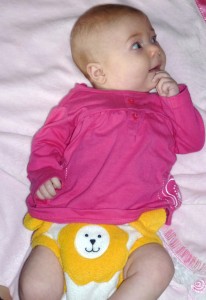Since Marion Donovan first invented disposable nappies in 1950 (and sold her company for $1 million a few years later), they have become the standard form of ‘diapering’ in the Western world. Back when my first child was born in 2002 I was one of only a few women I knew using tradition terry cloth nappies. By the time my third child came along in 2010, I was one of – well, zero actually. Because I’d made the switch to modern cloth nappies, and never looked back. Why?
They’re Frugal
Using cloth nappies can save you thousands of dollars over their life.
Purchasing a bunch of modern nappies can seem like a big expense up front – depending on the style you choose you could be up for anything from from about AU$10 or less each plus a few covers, to over AU$30 each. But, when you consider that a young baby might go through eight to 12 nappies a day, and even a toddler will likely use at least four, and most kids are in nappies for between two and three years – well, the cost of disposables really adds up.
On top of that, if you have more than one child, your cloth nappies will likely last through at least two or three children.
They’re Sustainable
Disposable nappies are bad for the environment. There’s really no two ways about that (unless you talk to Kimberly-Clark or some other manufacturer of them!). Even if there was some question about this back when cloth nappies were made from cotton and washed with harsh chemicals, there isn’t anymore.
Modern cloth nappies are now often made from more sustainable fabrics than cotton, namely, bamboo or hemp (though see our article on bamboo diapers for the low down on bamboo). Cotton requires an awful lot of water to grow and, unless you buy organic cotton, has also usually been grown with a load of pesticides. Hemp and bamboo do not. Disposable diapers, of course, are made largely from materials which are even less sustainable than cotton, and which take hundreds of years to break down.
As a bonus (both for the tired parent who doesn’t need any extra washing, and for the our tired water reserves), hemp and bamboo are also both far more absorbent than cotton, so the diapers need to be changed less often, and there are less of them to wash.
They’re Easy to Use
But are even modern cloth diapers as easy to use as disposables? Well, no. I won’t lie to you, of course they aren’t. You can’t just take them off and put them in the bin when you’re done, so – no, they aren’t quite as easy. But they are a lot easier than the old fashioned diapers our parents (or grandparents) used.
Whether you use fitted cloth diapers, all-in-ones (AIOs), or pocket diapers, they are shaped to fit your baby, just like disposables, and are easy to put on, usually fastening with velcro or snaps. Pocket diapers and especially pre-fold cloth diapers are a little more fiddly than AIOs and fitted diapers, but still pretty easy to use, as long as you have a good quality cover.
And, when you toddler get to the age where she keeps taking her nappy off? Yeah, thats when cloth nappies really come into their own for ease of use. For you that is. Not so much for her, she will likely find it harder to get off! (Though that does depend a bit on the sort you have – velcro tabs are pretty easy for little fingers to undo, but snaps, not so much).
They’re Even Easy to Wash

Gone are the days of nappy buckets (nappy pails I remember my mother calling them) filled with water and bleach. In fact, you shouldn’t use bleach at all with modern cloth nappies, as it damages the elastic. “Dry pailing” is now the recommended practice, which means just dumping it in the bucket and leaving it dry until you wash it.
If you are fully breastfeeding you won’t need to clean the nappy before washing at all. If you are bottle feeding or your baby has started solid food, you’ll want to scrap as much of the solids out of the nappy as you can (into the toilet) before dropping it in the bucket. Then, when you do your wash, if there was much left on the diaper you can do a pre-wash to rinse the diapers before the wash, but then just wash as usual.
You don’t need to use extra washing powder either, in fact the recommendation is that you use about half what you would for a normal wash, as excess washing powder collects in the nappies and can cause them to retain smells. And you don’t need to use extra hot water – warm or cold is fine – but ideally do dry your nappies in the sun, which is the best sterilising and bleaching substance there is (in the video below The Nappy Lady does recommend using hot water for washing newborn cloth diapers).
NB: In the video The Nappy Lady demonstrates with disposable liners – this obviates the need for scraping out the diaper, but it is also possible to use cloth liners. The liner not only keeps all the solids together making it easier to clean, a good cloth liner will work much like a disposable nappy to stay (relatively) dry next to the baby’s skin.
And, they’re cute
You can kind some awfully cute cloth nappies these days too. In fact “baby legs” – basically leg warmers for babies – were invented especially to be able to show off these gorgeous nappies without sacrificing comfort.
(Note: the baby photographed above is three months old in a size medium Starbunz nappy – it was a little big for her really.)
[Note, I updated article was updated March 2011 to correct a paragraph which implied disposable nappies were made from cotton]



